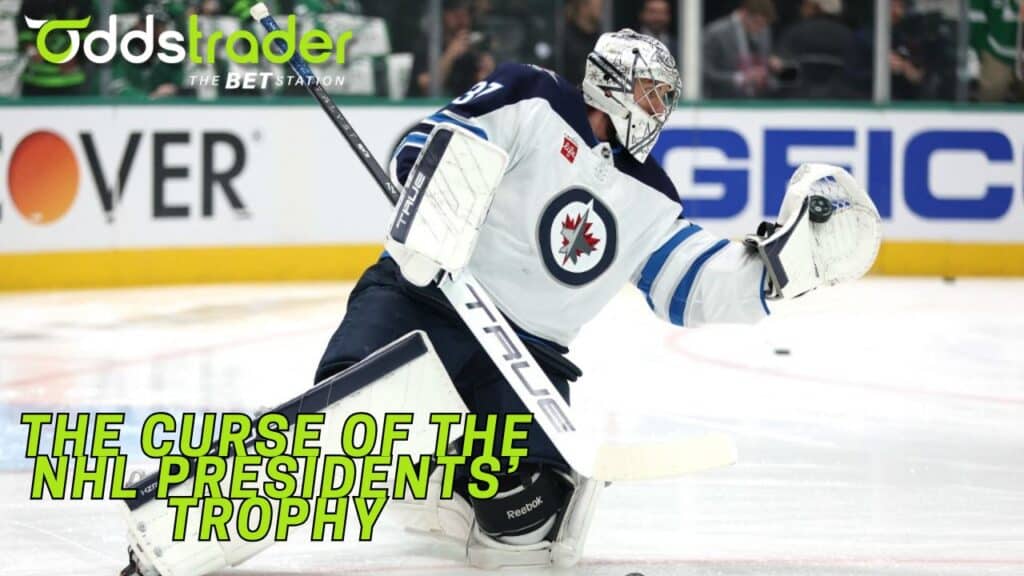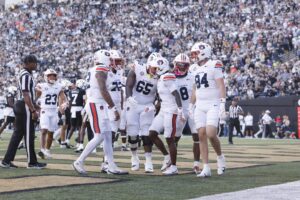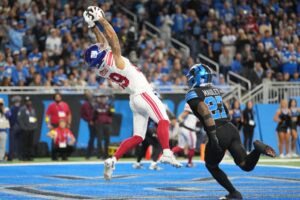
What Is the Presidents’ Trophy?
In the NHL, the Presidents’ Trophy is the prize for regular-season dominance. Since it was introduced in 1985-86, the award has gone to the team that finishes with the league’s best record.
At first glance, that should mean you’re looking at the favorite to win it all. After all, if you outlast 31 other teams across 82 games, the Cup should be within reach.
But hockey isn’t built that way. The Trophy is more about recognition than guarantee. It tells you a team mastered the marathon of the regular season, banking points night after night and usually running away with its division.
What it doesn’t tell you is how that team will hold up once the pace changes in April. The Stanley Cup playoffs are a different kind of test.
They’re a grind of best-of-seven series where injuries, cold streaks, and one hot goalie can flip everything upside down.
That’s what makes the Presidents’ Trophy such a fascinating piece of NHL culture. It’s prestigious, yes, but it comes with baggage. Fans know the history, and players can’t escape the questions.
Does finishing first mean you’re cursed? Or does it just mean you’re carrying the weight of expectations into a tournament that rarely goes according to script?
Why this matters: The Trophy sets the stage, but the Cup rewrites the story.
Next up: A look at the historical trends that turned perception into a lasting reputation.
Where Did the “Curse” Narrative Come From?
The “curse” label didn’t come from one bad season. It took shape after a string of top seeds stumbled in the playoffs. Teams that dominated from October to April suddenly looked ordinary when a playoff game was on the line. With each collapse, the sense of inevitability grew.
By the early 1990s, the pattern was noticeable. Winning the Presidents’ Trophy gave teams bragging rights, but it also raised questions about whether they could deliver when it mattered most. The “curse” label itself, however, gained real traction later, as the streak of non-Cup wins stretched through the 2000s and 2010s.
Headlines about regular-season champs crashing out only deepened the perception, turning what was meant as a reward for excellence into what some saw as a warning sign.
Hockey culture cemented the myth. Analysts mentioned it every spring, and fans debated it endlessly.
The term “curse” stuck not because of superstition, but because the failures piled up often enough to make the storyline irresistible.
Why this matters: The curse became part of hockey’s identity, not just its history.
Next up: A look at the historical trends that made the label hard to shake.
Historical Trends of Presidents’ Trophy Winners
The numbers tell the story. Since its debut in 1986, only eight Presidents’ Trophy winners have gone on to win the Stanley Cup.
For the rest, early exits have been far more common than parades, leaving the NHL top seed playoff record far less impressive than the regular-season standings suggest.
The 1990s gave fans a few exceptions, like the Rangers in 1994 and the Red Wings in 2002, but the bigger picture tells a different tale. Starting in the 2000s, playoff letdowns for top seeds became the norm, and the trend hasn’t reversed.
No Presidents’ Trophy winner has lifted the Cup since the Blackhawks in 2013, a drought that fuels the idea of a curse.
Part of the explanation is the unforgiving nature of the playoffs. Sixteen teams qualify, matchups are unpredictable, and momentum often matters more than a season-long record. Upsets are part of hockey’s DNA.
The Trophy rewards consistency across 82 games, while the Cup demands survival in a very different tournament.
Why this matters: History shows dominance in April rarely guarantees glory in June.
Complete List of Presidents’ Trophy Winners (1986-2025)
| Season | Team | Points | Playoff Result |
|---|---|---|---|
| 1985–86 | Edmonton Oilers | 119 | Lost in Conference Finals |
| 1986–87 | Edmonton Oilers | 106 | Stanley Cup Champions |
| 1987–88 | Calgary Flames | 105 | Lost in Stanley Cup Final |
| 1988–89 | Calgary Flames | 117 | Stanley Cup Champions |
| 1989–90 | New York Rangers | 85 (shortened) | Lost in Division Finals |
| 1990–91 | Chicago Blackhawks | 106 | Lost in Division Finals |
| 1991–92 | New York Rangers | 105 | Lost in Division Semifinals |
| 1992–93 | Pittsburgh Penguins | 119 | Lost in Division Finals |
| 1993–94 | New York Rangers | 112 | Stanley Cup Champions |
| 1994–95 | Detroit Red Wings | 70 (48-game season) | Lost in Stanley Cup Final |
| 1995–96 | Detroit Red Wings | 131 | Lost in Conference Finals |
| 1996–97 | Colorado Avalanche | 107 | Lost in Conference Finals |
| 1997–98 | Dallas Stars | 109 | Lost in Conference Finals |
| 1998–99 | Dallas Stars | 114 | Stanley Cup Champions |
| 1999–2000 | St. Louis Blues | 114 | Lost in Conference Semifinals |
| 2000–01 | Colorado Avalanche | 118 | Stanley Cup Champions |
| 2001–02 | Detroit Red Wings | 116 | Stanley Cup Champions |
| 2002–03 | Ottawa Senators | 113 | Lost in Conference Finals |
| 2003–04 | Detroit Red Wings | 109 | Lost in Conference Semifinals |
| 2005–06 | Detroit Red Wings | 124 | Lost in Conference Quarterfinals |
| 2006–07 | Buffalo Sabres | 113 | Lost in Conference Finals |
| 2007–08 | Detroit Red Wings | 115 | Stanley Cup Champions |
| 2008–09 | San Jose Sharks | 117 | Lost in Conference Quarterfinals |
| 2009–10 | Washington Capitals | 121 | Lost in Conference Quarterfinals |
| 2010–11 | Vancouver Canucks | 117 | Lost in Stanley Cup Final |
| 2011–12 | Vancouver Canucks | 111 | Lost in Conference Quarterfinals |
| 2012–13 | Chicago Blackhawks | 77 (48-game season) | Stanley Cup Champions |
| 2013–14 | Boston Bruins | 117 | Lost in Conference Semifinals |
| 2014–15 | New York Rangers | 113 | Lost in Conference Finals |
| 2015–16 | Washington Capitals | 120 | Lost in Conference Semifinals |
| 2016–17 | Washington Capitals | 118 | Lost in Conference Semifinals |
| 2017–18 | Nashville Predators | 117 | Lost in Conference Semifinals |
| 2018–19 | Tampa Bay Lightning | 128 | Lost in Conference Quarterfinals |
| 2019–20 | Boston Bruins | 100 (COVID-shortened) | Lost in Second Round |
| 2020–21 | Colorado Avalanche | 82 (56-game season) | Lost in Second Round |
| 2021–22 | Florida Panthers | 122 | Lost in Second Round |
| 2022–23 | Boston Bruins | 135 | Lost in Conference Quarterfinals |
| 2023–24 | New York Rangers | 114 | Lost in Eastern Conference Final |
| 2024–25 | Winnipeg Jets | 116 | Lost in the Second Round |
Famous Collapses That Fuel the Curse
The Presidents’ Trophy curse gained traction because of a few unforgettable failures. These famous Presidents’ Trophy collapses are still talked about whenever the playoffs roll around.
In 1996, the Detroit Red Wings set a then-record with 62 wins, only to fall to the Colorado Avalanche in the Western Conference Final. It wasn’t just an upset; it became the start of a heated rivalry.
The 2010 Washington Capitals, led by Alex Ovechkin, looked unstoppable but were stunned in the first round by the eighth-seeded Montreal Canadiens. Jaroslav Halak’s goaltending turned the series into one of the most memorable NHL playoff upsets of the era.
The 2019 Tampa Bay Lightning tied Detroit’s 62-win mark and entered as heavy favorites. Instead, they were swept in the first round by Columbus in a result that shocked the entire sports world.
And in 2023, the Boston Bruins set a new NHL record with 65 wins, only to blow a 3-1 series lead against the Florida Panthers. What looked like a dream season ended in sudden heartbreak.
Why this matters: These collapses cemented the Trophy’s reputation as a burden, not a blessing.
Presidents’ Trophy Winners Eliminated in the First Round
| Season | Team | Playoff Result |
|---|---|---|
| 1991–92 | New York Rangers | Lost to Pittsburgh Penguins |
| 2005–06 | Detroit Red Wings | Lost to Edmonton Oilers |
| 2008–09 | San Jose Sharks | Lost to Anaheim Ducks |
| 2011–12 | Vancouver Canucks | Lost to Los Angeles Kings |
| 2018–19 | Tampa Bay Lightning | Swept by Columbus Blue Jackets |
| 2019–20* | Boston Bruins | Lost early in bubble playoffs (COVID) |
| 2022–23 | Boston Bruins | Lost to Florida Panthers |
*2020 Bruins note: Some lists include this as a “first-round exit” due to the unusual COVID bubble format, though technically it was a second-round elimination.
Why Top Teams Fall Short
The so-called curse isn’t magic. It’s about the realities of playoff hockey. Analysts and fans point to several reasons why Presidents’ Trophy teams fail in playoffs, and each one helps explain the pattern.
Pressure and Expectations
Carrying the label of “best team in hockey” comes with a spotlight. Every mistake feels magnified, and every loss feeds the narrative that the top seed can’t finish the job. Opponents use that pressure as fuel, while the Trophy winner often plays with the weight of expectation instead of freedom.
Playoff vs. Regular Season Style
The regular season rewards speed, skill, and depth over the long haul. The playoffs reward something else entirely. Games slow down, defenses tighten, and referees swallow the whistle.
A goaltender on a hot streak can erase the advantage of a roster stacked with talent. That’s why a regular-season powerhouse can look ordinary in a seven-game series.
Momentum and Meaningful Games
Lower seeds usually claw their way into the playoffs by fighting for every point down the stretch. An eighth seed often spends its final weeks in survival mode, playing each night like an elimination game.
By the time the postseason starts, they’re sharp and battle-tested. Top seeds, by contrast, sometimes clinch early and coast into April without the same urgency.
When these two mental states collide, it’s not unusual for the hungrier team to come out on top.
Parity in the NHL
Unlike other sports, the NHL thrives on competitive balance. The gap between the first seed and the last playoff spot is often razor thin. That parity makes upsets part of the league’s identity.
A Presidents’ Trophy team may look unbeatable over 82 games, but once the bracket resets, the playing field levels in a hurry.
Why this matters: The curse reflects hockey’s design. Playoffs reward urgency, balance, and resilience over dominance.
Breaking the Curse – Counterexamples
The curse isn’t absolute. A few teams have shown that winning the Presidents’ Trophy and the Stanley Cup in the same year is possible. In fact, if you’re wondering how many Presidents’ Trophy winners won the Stanley Cup, the answer is just eight.
Those rare champions share some common traits.
The Edmonton Oilers in 1987 and the Calgary Flames in 1989 both had generational rosters loaded with Hall of Fame talent. For them, the Trophy was just a milestone on the way to the Cup.
The New York Rangers in 1994 ended a 54-year drought by riding Mark Messier’s leadership, elite goaltending from Mike Richter, and a defensive system built for playoff hockey.
The Dallas Stars in 1999 pulled it off as well, with balance across all four lines and a lockdown defensive corps.
Colorado’s 2001 team and Detroit’s 2002 squad are often cited as blueprints. Both had depth at every position, veteran cores that had already won, and a clear understanding of playoff demands.
Detroit repeated the feat again in 2008, proving the formula could work even in a more modern, parity-driven NHL.
The last team to do it was the Chicago Blackhawks in 2013. That group combined playoff experience, star power, and a relentless two-way style that translated perfectly from regular season to postseason.
These teams didn’t just dominate the standings; they were built to withstand the grind. Depth, leadership, and goaltending separated them from the long list of top seeds that fell short.
Why this matters: Counterexamples prove the curse can be beaten, but only by teams built for every scenario.
The Only NHL Teams To Defy The Curse
| Year | Team | What Set Them Apart |
|---|---|---|
| 1987 | Edmonton Oilers | Generational roster with Gretzky, Messier, and elite scoring depth |
| 1989 | Calgary Flames | Balanced attack, strong defense, and top-tier goaltending |
| 1994 | New York Rangers | Veteran leadership, Richter in net, and Messier’s defining presence |
| 1999 | Dallas Stars | Defensive structure, depth across four lines, and clutch scoring |
| 2001 | Colorado Avalanche | Dominant two-way play, Sakic and Roy leading the charge |
| 2002 | Detroit Red Wings | Hall of Fame–level roster, unmatched depth, and playoff-tested veterans |
| 2008 | Detroit Red Wings | Modern-style dominance, puck possession, and elite blue line |
| 2013 | Chicago Blackhawks | Speed, two-way play, and a core that thrived under pressure |
These teams didn’t just dominate the standings; they were built to survive the playoffs. They had depth, leadership, and goaltending that translated when the game slowed down and pressure intensified.
Why this matters: Counterexamples prove the curse can be beaten, but only by teams built for every scenario.
Why the Storyline Endures
The Presidents’ Trophy curse has lasted because it isn’t just about results. It’s about the way fans and media have embraced the narrative.
Every spring, broadcasters remind viewers of the poor track record, and fans bring up past collapses as soon as a top seed shows signs of weakness. The idea has become part of the sport’s culture.
Superstition also plays a role. Hockey is a game full of rituals and unwritten rules, and once a label like “curse” sticks, it’s hard to shake.
Even players who don’t buy into myths can’t avoid the questions. When the Trophy winner stumbles, it feels like proof the storyline still applies.
The curse also feeds into a deeper fan instinct: the love of an underdog. There’s something inherently satisfying about an eighth seed knocking out the league’s best team.
Those upsets aren’t just results, they’re reminders that the Cup is about survival, not reputation. That keeps the debate alive every season. Can the Presidents’ Trophy winner win the Stanley Cup, or is it doomed to fall short?
In the end, the storyline endures because it reflects broader Stanley Cup trends. Regular-season success and playoff success are two different achievements.
The Trophy rewards the grind of 82 games; the Cup crowns the team that can endure the chaos of four playoff rounds.
Why this matters: The curse persists because it blends history, culture, and the thrill of the upset.
The Last Word
The Presidents’ Trophy is a mark of excellence, but it has never guaranteed the ultimate prize. It rewards a team for dominating the regular season, for proving consistency over six months of hockey. Yet the Stanley Cup asks for something different: resilience, urgency, and the ability to withstand four grueling rounds where momentum can swing on a single shift.
That’s why the curse remains part of the NHL conversation. It blends history, numbers, and drama in a way fans never get tired of revisiting.
Each new season, the narrative resets: will the best regular-season team finally prove it can carry its dominance into June, or will the storyline repeat itself yet again?
The Trophy may set the stage, but the Cup writes the ending. And as long as hockey has upsets, hot goalies, and underdogs rising to the moment, the debate about the Presidents’ Trophy curse will remain as relevant as ever.
Why this matters: The curse endures because it turns every playoff run into must-watch theater.
FAQs
How many Presidents’ Trophy winners have won the Stanley Cup?
Only eight teams have managed to win both in the same season. The most recent was the Chicago Blackhawks in 2013, proving it’s rare but not impossible.
Why do Presidents’ Trophy teams fail in playoffs so often?
It’s usually a mix of pressure, tougher playoff styles, and the momentum of lower-seeded teams that had to fight just to get in. By the time the postseason starts, those underdogs are sharp and battle-tested.
Does winning the Presidents’ Trophy matter if teams keep falling short?
Yes. It still marks six months of dominance and is a major accomplishment. But it also carries the weight of expectation, which can be tough to carry into the playoffs.
Can the Presidents’ Trophy winner win the Stanley Cup again?
Absolutely. History shows it’s difficult, but not impossible. Teams with depth, leadership, and strong goaltending have broken through before, and another team will eventually do it again.






